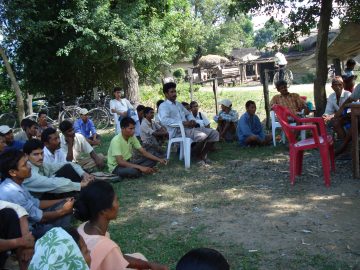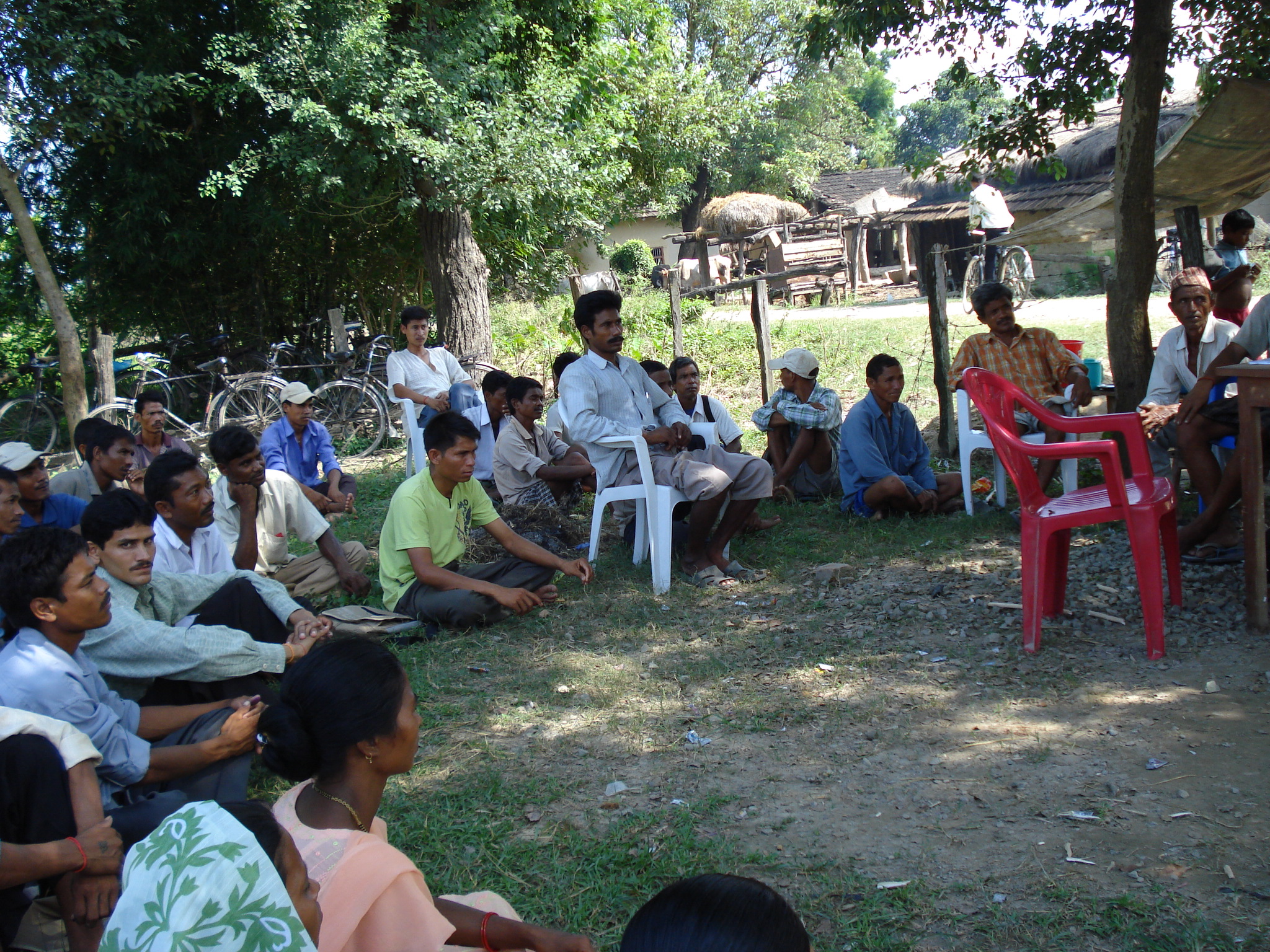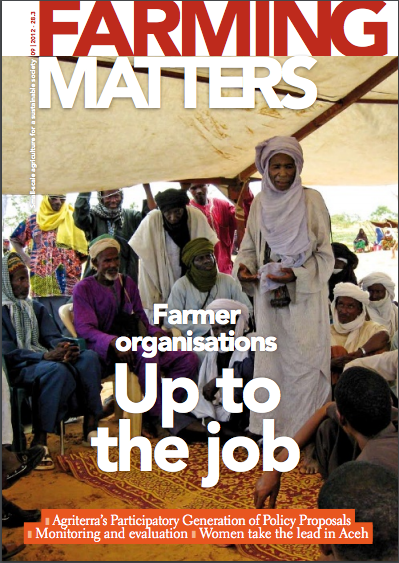Many projects and development efforts fail because they do not pay sufficient attention to ensuring that farmers’ organisations represent all farmers, or to using participatory processes to identify and address the problems farmers face. Nepal’s Biodiversity Conservation and Development Committees (BCDCs), which aim to conserve and utilise local crop species and varieties, focus on both aspects and are proving to be very effective.

Many farmer groups in Nepal were originally set up to help disseminate new technologies and extension services to large numbers of farmers – an approach that has been adopted by many development organisations. But the link between farmers and their groups, and the conservation and sustainable use of agricultural biodiversity, has often been underrated and neglected, both in terms of policies and practices.
As a consequence, too few farmers are aware of biodiversity-related activities, and farming communities are losing their genetic resources and becoming increasingly dependent on outside sources for seeds and planting materials.
Working with farmer organisations has been the approach of LI-BIRD (Local Initiatives for Biodiversity, Research and Development), a non-governmental organisation in Nepal. Complementing previous efforts on on-farm conservation, this “inclusive” approach started in the Kaski district in central Nepal in 2006, leading to the establishment of a BCDC. Until now, a total of 30 BCDCs have been formed across Nepal.
The formation and structure of BCDCs
Like all districts, Kaski is divided into several Village Development Committees (VDCs, the equivalent of a municipality). Each VDC is further divided into nine wards. These administrative units are autonomous, but lack the mandate or the resources to carry out research or other activities related to agriculture and biodiversity. Realising this gap, and keen to promote participatory processes, we started our work with a series of ward-level meetings, aiming to establish ward-level BCDCs in one of Kaski’s VDCs, Rupakot.
Each committee was to consist of nine members, including women, dalit and indigenous people, and had to elect a chairperson, vice chairperson, secretary and treasurer. This process was repeated in all nine wards and a VDC-level committee was formed with a representative from each ward.
All VDC households became committee members by default. But setting up the BCDC also meant preparing bylaws and internal rules and procedures for electing representatives, and determining the committee’s mandate. Since 2006, the mandate has been to ensure the conservation and sustainable use of the area’s genetic resources through a community-based planning process, and undertaking specific activities towards this goal. A general assembly takes place every year with the participation of all BCDC members, sharing the results achieved and developing a work plan for the coming year.
Individuals, groups and benefits
Farmers are interested in higher yields and incomes, but are they also interested in joining hands to conserve local biodiversity? It is very difficult to include all farmers in conservation-related activities, but the BCDCs do aim to involve most of them in different ways: with home gardens or by producing and marketing seeds. These approaches increase farmers’ awareness of the importance of conserving local agrobiodiversity while, at the same time, showing long-term benefits.
Linking local biodiversity with markets can help farmers’ significantly increase their incomes, making them more willing to grow some species.
These benefits are now widely visible. Farmers in a BCDC in Begnas Kaski (in Lekhnath, central Nepal) are marketing local foods such as masaura, tandra, gava and khasaura (made of taro leaves, stem and roots), and anadi rice (a sticky rice which has cultural value and medicinal properties).
The BCDC in Shivagunj, in the Jhapa district, produces and sells a local aromatic rice variety named kalonuniya, which fetches a much higher price than other varieties; while farmers in the BCDC of Ghanteshower, in the Doti district, process and market a traditional vinegar using local citrus varieties. All these enterprises are owned by the groups and the benefits are shared equally between all members.
Not all species and varieties can be marketed. But many local varieties have other benefits: they are context-specific and are resilient to the changing environmental conditions. This is especially important in a country like Nepal, where most villagers cultivate plots in different locations, with different agro-ecological conditions, appropriate to different crops and varieties.
Farmers also like to grow a range of varieties to meet different economic, cultural and social needs. This means that many of them grow “modern” varieties and hybrids for the market and local varieties for home consumption.
Our sensitisation efforts build on this approach: we engage local farmers in different activities and let them assess the values of different species in a way that they realise the significance and benefits of biodiversity.
Participatory planning and implementation
Individuals, groups and benefits
Farmers are interested in higher yields and incomes, but are they also interested in joining hands to conserve local biodiversity? It is very difficult to include all farmers in conservation-related activities, but the BCDCs do aim to involve most of them in different ways: with home gardens or by producing and marketing seeds. These approaches increase farmers’ awareness of the importance of conserving local agrobiodiversity while, at the same time, showing long-term benefits.
Linking local biodiversity with markets can help farmers’ significantly increase their incomes, making them more willing to grow some species.
These benefits are now widely visible. Farmers in a BCDC in Begnas Kaski (in Lekhnath, central Nepal) are marketing local foods such as masaura, tandra, gava and khasaura (made of taro leaves, stem and roots), and anadi rice (a sticky rice which has cultural value and medicinal properties).
The BCDC in Shivagunj, in the Jhapa district, produces and sells a local aromatic rice variety named kalonuniya, which fetches a much higher price than other varieties; while farmers in the BCDC of Ghanteshower, in the Doti district, process and market a traditional vinegar using local citrus varieties. All these enterprises are owned by the groups and the benefits are shared equally between all members.
Not all species and varieties can be marketed. But many local varieties have other benefits: they are context-specific and are resilient to the changing environmental conditions. This is especially important in a country like Nepal, where most villagers cultivate plots in different locations, with different agro-ecological conditions, appropriate to different crops and varieties.
Farmers also like to grow a range of varieties to meet different economic, cultural and social needs. This means that many of them grow “modern” varieties and hybrids for the market and local varieties for home consumption.
Our sensitisation efforts build on this approach: we engage local farmers in different activities and let them assess the values of different species in a way that they realise the significance and benefits of biodiversity.
Once the committee was established we started with an awareness raising campaign and a series of capacity building activities, aiming to sensitise the farming community on the importance of local biodiversity, and to get people engaged in conservation initiatives.
This was first organised by LI-BIRD, but the role was gradually taken by the BCDCs themselves. They began to organise village “diversity fairs”, village workshops, exchange visits, rural song and dance competitions, and diverse activities with schools.
Given the importance of understanding the local context before starting any intervention, another key activity has been the documentation of local agricultural biodiversity, traditional knowledge and related innovations. This involved setting up a Community Biodiversity Register, a participatory inventory which identifies the most interesting practices.
Together with other organisations, LI-BIRD has also trained a few members of each BCDC to document the local crops and varieties, local practices and ideas, and then develop an action plan.
These plans included setting up community seed banks or home gardens. LI-BIRD provided some initial funding but all the BCDCs have gradually taken on the role of mobilising local resources.
A biodiversity management fund was also established in Kaski, and later in every BCDC. The fund gives loans at a low interest rate, giving priority to the poor and needy within each village, helping them start different income generation activities (such as rearing animals, adding value or marketing local foods).
An important provision for taking a loan is that the borrower has to grow at least one rare and unique crop and distribute its seeds to other members. These funds are completely owned and managed by each BCDC, and have to comply with rules approved by the general assembly.
The results show that this is not just another form of microcredit to increase access to financial resources. Each fund generates a regular income in the form of interest for the BCDC. This means the groups are able to continue working after external support stops.
Promoting farmers’ rights
These initiatives have helped farmers recognise the importance of their genetic resources, but have also helped them see the importance of issues such as ownership and control.
The Nepalese Government has ratified the International Treaty on Plant Genetic Resources for Food and Agriculture (ITPGRFA) and the development of national legislation is underway. However, very few farmers know about the inclusion of farmers’ rights or about the implications of the new laws. One of the reasons for this is the lack of proper mechanisms to communicate with farmers. The establishment of farmers’ organisations, such as the BCDCs, could play an important role here. As legal owners of all genetic resources, farmers are to approve their use by outsiders. Representing farmers, a BCDC could help ensure that the economic benefits reach them.
There is still a lot to do, but we feel we are on the right track. Two years ago LI-BIRD facilitated a two-day workshop of BCDCs, involving genetic resources experts, lawyers and representatives of the Ministry of Agriculture Development and of the National Gene Bank. One of the results of this meeting was the establishment of the Agriculture Development and Conservation Farmers Committee and the drafting of the “Pokhara Declaration”, which was shared with more than 600 members of Nepal’s Constituent Assembly.
The Ministry of Agriculture Development, together with LI-BIRD and the National Agriculture Research Council, has started a genetic resources policy initiatives project, which involves farmers as representatives of the aforementioned ad hoc committee. The goal is to join all Nepal’s BCDCs into one nationwide organisation of farmers, and thereby promote our dual objectives: conservation and development.
Pitambar Shrestha and Pashupati Chaudhary
Pitambar Shrestha (pitambar@libird.org) and Pashupati Chaudhary (pchaudhary@libird.org) work at Local Initiatives for Biodiversity, Research and Development (LI-BIRD). PO Box 324, Gairapatan, Pokhara, Kaski, Nepal. For more information, visit their website: www.libird.org


